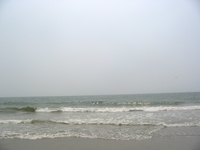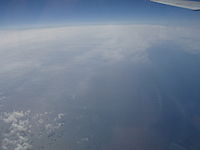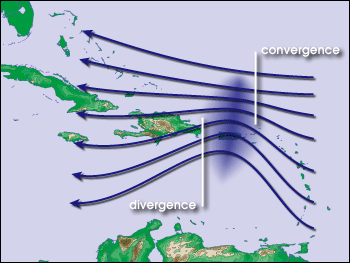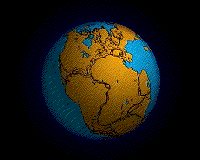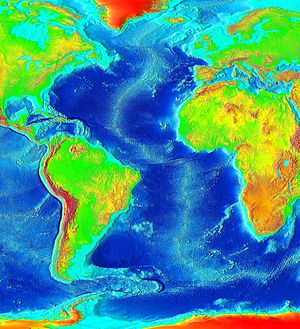
Atlantic Ocean
Background to the schools Wikipedia
Arranging a Wikipedia selection for schools in the developing world without internet was an initiative by SOS Children. All children available for child sponsorship from SOS Children are looked after in a family home by the charity. Read more...
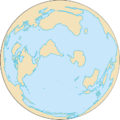 |
| Earth's oceans |
|---|
|
World Ocean |
The Atlantic Ocean is the second-largest of the world's oceanic divisions; with a total area of about 106.4 million square kilometres (41.1 million square miles). It covers approximately one-fifth of the Earth's surface. The first part of its name refers to the Atlas of Greek mythology, making the Atlantic the "Sea of Atlas". The oldest known mention of this name is contained in The Histories of Herodotus around 450 BC (I 202); see also: Atlas Mountains. Before Europeans discovered other oceans, the term "ocean" was synonymous with the waters beyond Western Europe that we now know as the Atlantic and which the Greeks had believed to be a gigantic river encircling the world; see Oceanus.
The Atlantic Ocean occupies an elongated, S-shaped basin extending longitudinally between the Americas to the west, and Eurasia and Africa to the east. A component of the all-encompassing World Ocean, it is connected in the north to the Arctic Ocean (which is sometimes considered a sea of the Atlantic), to the Pacific Ocean in the southwest, the Indian Ocean in the southeast, and the Southern Ocean in the south. (Alternatively, in lieu of it connecting to the Southern Ocean, the Atlantic may be reckoned to extend southward to Antarctica.) The equator subdivides it into the North Atlantic Ocean and South Atlantic Ocean.
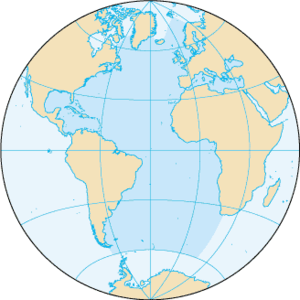
Geography
The Atlantic Ocean is bounded on the west by North and South America. In the north and northeast, it is separated from the Arctic Ocean by the Canadian Arctic Archipelago, Greenland, Iceland, Jan Mayen, Svalbard, and mainland Europe. It connects to the Arctic Ocean through the Denmark Strait, Greenland Sea, Norwegian Sea, and Barents Sea. To the east, the boundaries of the ocean proper are Europe, the Strait of Gibraltar (where it connects with the Mediterranean Sea, one of its marginal seas, and, in turn, the Black Sea), and Africa. In the southeast, the Atlantic merges into the Indian Ocean, the border being defined by the 20° East meridian, running south from Cape Agulhas to Antarctica. While some authorities show the Atlantic Ocean extending south to Antarctica, others show it as bounded at the 60° parallel by the Southern Ocean. In the southwest, the Drake Passage connects it to the Pacific Ocean. A man-made link between the Atlantic and Pacific is provided by the Panama Canal. Beside those mentioned, other large bodies of water adjacent to the Atlantic are the Caribbean Sea, the Gulf of Mexico, Hudson Bay, the Arctic Ocean, the Mediterranean Sea, the North Sea, the Baltic Sea, and the Celtic Sea.
Covering approximately 22% of Earth's surface, the Atlantic Ocean is second only to the Pacific Ocean in size. With its adjacent seas it occupies an area of about 106,400,000 square kilometers (41,100,000 sq mi); without them, it has an area of 82,400,000 square kilometres (31,800,000 sq mi). The land area that drains into the Atlantic is four times that of either the Pacific or Indian oceans. The volume of the Atlantic Ocean with its adjacent seas is 354,700,000 cubic kilometers (85,100,000 cu mi) and without them 323,600,000 cubic kilometres (77,640,000 cu mi).
The average depths of the Atlantic, with its adjacent seas, is 3,339 meters (10,936 ft); without them it is 3,926 metres (12,881 ft). The greatest depth, 8,605 metres (28,232 ft), is in the Puerto Rico Trench. The width of the Atlantic varies from 2,848 kilometers (1,770 mi) between Brazil and Sierra Leone to over 4,000 mi (6,400 km) in the south.
Ocean bottom
The principal feature of the bathymetry (bottom topography) of the Atlantic Ocean is a submarine mountain range called the Mid-Atlantic Ridge. It extends from Iceland in the north to approximately 58° South latitude, reaching a maximum width of about 1,600 kilometres (1,000 mi). A great rift valley also extends along the ridge over most of its length. The depth of water over the ridge is less than 2,700 m (8,900 ft) in most places, and several mountain peaks rise above the water and form islands. The South Atlantic Ocean has an additional submarine ridge, the Walvis Ridge.
The Mid-Atlantic Ridge separates the Atlantic Ocean into two large troughs with depths averaging between 3,700 and 5,500 metres (12,000 and 18,000 ft). Transverse ridges running between the continents and the Mid-Atlantic Ridge divide the ocean floor into numerous basins. Some of the larger basins are the Blake, Guiana, North American, Cape Verde, and Canaries basins in the North Atlantic. The largest South Atlantic basins are the Angola, Cape, Argentina, and Brazil basins.
The deep ocean floor is thought to be fairly flat, although numerous seamounts and some guyots exist. Several deeps or trenches are also found on the ocean floor. The Puerto Rico Trench, in the North Atlantic, is the deepest. The Laurentian Abyss is found off the eastern coast of Canada. In the South Atlantic, the South Sandwich Trench reaches a depth of 8,428 metres (27,651 ft). A third major trench, the Romanche Trench, is located near the equator and reaches a depth of about 7,454 metres (24,455 ft). The shelves along the margins of the continents constitute about 11% of the bottom topography. Several deep channels cut across the continental rise.
Ocean sediments are composed of terrigenous, pelagic, and authigenic material. Terrigenous deposits consist of sand, mud, and rock particles formed by erosion, weathering, and volcanic activity on land and then washed to sea. These materials are found mostly on the continental shelves and are thickest off the mouths of large rivers or off desert coasts. Pelagic deposits, which contain the remains of organisms that sink to the ocean floor, include red clays and Globigerina, pteropod, and siliceous oozes. Covering most of the ocean floor and ranging in thickness from 60 to 3,300 metres (200 to 11,000 ft), they are thickest in the convergence belts and in the zones of upwelling. Authigenic deposits consist of such materials as manganese nodules. They occur where sedimentation proceeds slowly or where currents sort the deposits
Water characteristics
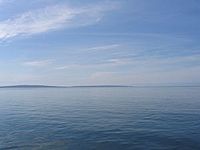
On average, the Atlantic is the saltiest of the world's major oceans; the salinity of the surface waters in the open ocean ranges from 33 to 37 parts per thousand (3.3 - 3.7%) by mass and varies with latitude and season. Surface salinity values are influenced by evaporation, precipitation, river inflow, and melting of sea ice. Although the minimum salinity values are found just north of the equator (because of heavy tropical rainfall), in general the lowest values are in the high latitudes and along coasts where large rivers flow into the ocean. Maximum salinity values occur at about 25° north and south of the equator, in subtropical regions with low rainfall and high evaporation.
Surface water temperatures, which vary with latitude, current systems, and season and reflect the latitudinal distribution of solar energy, range from less than −2 °C to 29 °C (28 ° F to 84 °F). Maximum temperatures occur north of the equator, and minimum values are found in the polar regions. In the middle latitudes, the area of maximum temperature variations, values may vary by 7 °C to 8 °C (13 °F to 14 °F).
The Atlantic Ocean consists of four major water masses. The North and South Atlantic central waters constitute the surface waters. The sub-Antarctic intermediate water extends to depths of 1,000 metres (3,300 ft). The North Atlantic Deep Water reaches depths of as much as 4,000 metres (13,200 ft). The Antarctic Bottom Water occupies ocean basins at depths greater than 4,000 metres (13,200 ft).
Within the North Atlantic, ocean currents isolate a large elongated body of water known as the Sargasso Sea, in which the salinity is noticeably higher than average. The Sargasso Sea contains large amounts of seaweed and is also the spawning ground for both the European eel and the American eel.
Because of the Coriolis effect, water in the North Atlantic circulates in a clockwise direction, whereas water circulation in the South Atlantic is counter-clockwise. The south tides in the Atlantic Ocean are semi-diurnal; that is, two high tides occur during each 24 lunar hours. The tides are a general wave that moves from south to north. In latitudes above 40° North some east-west oscillation occurs.
Climate
The climate of the Atlantic Ocean and adjacent land areas is influenced by the temperatures of the surface waters and water currents as well as the winds blowing across the waters. Because of the ocean's great capacity for retaining heat, maritime climates are more moderate and have less tendency toward extreme seasonal variations than inland climates. Precipitation can be approximated from coastal weather data and air temperature from the water temperatures. The oceans are the major source of the atmospheric moisture that is obtained through evaporation. Climatic zones vary with latitude; the warmest climatic zones stretch across the Atlantic north of the equator. The coldest zones are in the high latitudes, with the coldest regions corresponding to the areas covered by sea ice. Ocean currents contribute to climatic control by transporting warm and cold waters to other regions. Adjacent land areas are affected by the winds that are cooled or warmed when blowing over these currents. The Gulf Stream and its northern extension towards Europe, the North Atlantic Drift, for example, warms the atmosphere of the British Isles and north-western Europe, and the cold water currents contribute to heavy fog off the coast of eastern Canada (the Grand Banks area) and the north-western coast of Africa. In general, winds tend to transport moisture and warm or cool air over land areas. Hurricanes develop in the southern part of the North Atlantic Ocean.
History
The Atlantic Ocean appears to be the second youngest of all five oceans. Evidence indicates that it did not exist prior to 130 million years ago, when the continents that formed from the breakup of the ancestral super continent, Pangaea, were being rifted apart by the process of seafloor spreading. The Atlantic has been extensively explored since the earliest settlements were established along its shores. The Vikings, the Portuguese, and Christopher Columbus were the most famous among its early explorers. After Columbus, European exploration rapidly accelerated, and many new trade routes were established. As a result, the Atlantic became and remains the major artery between Europe and the Americas (known as transatlantic trade). Numerous scientific explorations have been undertaken, most famously the Challenger expedition, but also including those by the German Meteor expedition, Columbia University's Lamont Geological Observatory, and the United States Navy Hydrographic Office.
While there is evidence of pre-Columbian trans-oceanic contact of various dates, here are some important recent events in relation to the Atlantic:
- In 1000, Leif Eiriksson is the first European to discover the Atlantic coast of North America, including Vinland. The Norse discovery is documented in the 13th century Icelandic Sagas and is corroborated by recent archeological evidence.
- In 1003, Thorfinnr Karlsefni leads an attempted Viking settlement in North America but is driven off by the natives.
- In 1004, Snorri Thorfinsson is the first European born on the American continent.
- In 1492, Christopher Columbus lands somewhere in the Bahamas.
- In 1524, Italian explorer Giovanni da Verrazzano discovers the Atlantic coast of what is today the United States of America.
- In 1858, the first transatlantic telegraph cable was laid by Cyrus West Field, though it rapidly failed.
- In 1865 the first successful transatlantic telegraph cable was laid by Brunel's ship the Great Eastern.
- On April 15, 1912 the RMS Titanic sank after hitting an iceberg with loss of 1,593 people.
- In 1919, the American NC-4 became the first fixed-wing aircraft (seaplane) to cross the Atlantic (though it made a couple of landings on islands and the sea along the way, and taxied several hundred miles on the surface).
- Later in 1919, a British aeroplane piloted by Alcock and Brown made the first non-stop transatlantic flight, from Newfoundland to Ireland.
- In 1921, the British were the first to cross the North Atlantic in an airship.
- In 1922, the Portuguese were the first to cross the South Atlantic in an airship.
- The first transatlantic telephone call was made on January 7, 1927.
- In 1927, Charles Lindbergh made the first solo non-stop transatlantic flight in an aircraft (between New York City and Paris).
- In 1952, Ann Davison was the first woman to single-handedly sail the Atlantic Ocean.
- In 1980, Gérard d'Aboville is the first man to cross the Atlantic Ocean rowing.
- In 1994, Guy Delage was the first man to swim across the Atlantic Ocean, from the Cape Verde islands to Barbados.
- In 1998, Benoit Lecomte was the first man to swim across the northern Atlantic Ocean, stopping for only one week in the Azores.
- After rowing for 81 days and 4,767 kilometres (2,962 mi), on December 3, 1999, Tori Murden became the first woman to cross the Atlantic Ocean by rowboat alone when she reached Guadeloupe from the Canary Islands.
Economy
The ocean has also contributed significantly to the development and economy of the countries around it. Besides its major transatlantic transportation and communication routes, the Atlantic offers abundant petroleum deposits in the sedimentary rocks of the continental shelves and the world's richest fishing resources, especially in the waters covering the shelves. The major species of fish caught are cod, haddock, hake, herring, and mackerel. The most productive areas include the Grand Banks of Newfoundland, the shelf area off Nova Scotia, Georges Bank off Cape Cod, the Bahama Banks, the waters around Iceland, the Irish Sea, the Dogger Bank of the North Sea, and the Falkland Banks. Eel, lobster, and whales have also been taken in great quantities. All these factors, taken together, tremendously enhance the Atlantic's great commercial value. Because of the threats to the ocean environment presented by oil spills, marine debris, and the incineration of toxic wastes at sea, various international treaties exist to reduce some forms of pollution.
Terrain
The surface is usually covered with sea ice in the Labrador Sea, Denmark Strait, and Baltic Sea from October to June. There is a clockwise warm-water gyre in the northern Atlantic, and a counter-clockwise warm-water gyre in the southern Atlantic. The ocean floor is dominated by the Mid-Atlantic Ridge, a rugged north-south centerline for the entire Atlantic basin, first discovered by the Challenger Expedition. This was formed by the vulcanism that also formed the floor of the Atlantic, and the islands rising from it.
The Atlantic Ocean has irregular coasts indented by numerous bays, gulfs, and seas. These include Norwegian Sea, Baltic Sea, North Sea, Labrador Sea, Black Sea, Gulf of St. Lawrence, Bay of Fundy, Gulf of Maine, Mediterranean Sea, Gulf of Mexico, and Caribbean Sea.
Islands in the Atlantic Ocean include Greenland, Iceland, Faroe Islands, The British Isles (including Great Britain, Ireland and numerous surrounding islands), Rockall, Newfoundland, Sable Island, Azores, Madeira, Bermuda, Canary Islands, Caribbean, Cape Verde, Sao Tome e Principe, Annobon Province, St. Peter, Fernando de Noronha, Rocas Atoll, Ascension Island, Saint Helena, The Islands of Trindad, Tristan da Cunha, Diego Alverez (Also known as Gough Island), Falkland Islands, Tierra del Fuego, South Georgia Island, South Sandwich Islands, and Bouvet Island.
Elevation extremes
- lowest point: Milwaukee Deep in the Puerto Rico Trench −8,605 metres (-28,232 ft)
- highest point: sea level, 0 m (0 ft)
Natural hazards
Icebergs are common in the Davis Strait, Denmark Strait, and the northwestern Atlantic Ocean from February to August and have been spotted as far south as Bermuda and the Madeira Islands. Ships are subject to superstructure icing in extreme northern Atlantic from October to May Persistent fog can be a maritime hazard from May to September, as can hurricanes north of the equator (May to December).
The Bermuda Triangle is popularly believed to be the site of numerous aviation and shipping incidents because of unexplained and supposedly mysterious causes, but coast guard records do not support this belief.
Current environmental issues
Endangered marine species include the manatee, seals, sea lions, turtles, and whales. Drift net fishing is killing dolphins, albatrosses and other seabirds ( petrels, auks), hastening the decline of fish stocks and contributing to international disputes. There is municipal sludge pollution off the eastern United States, southern Brazil, and eastern Argentina; oil pollution in the Caribbean Sea, Gulf of Mexico, Lake Maracaibo, Mediterranean Sea, and North Sea; and industrial waste and municipal sewage pollution in the Baltic Sea, North Sea, and Mediterranean Sea.
In 2005, there was some concern that the currents warming northern Europe were slowing down, but no scientific consensus was formed based on the reported evidence.
On June 7, 2006, Florida's wildlife commission voted to take the manatee off the state's endangered species list. Some environmentalists worry that this could erode safeguards for the popular sea creature.
Marine pollution
Marine pollution is a generic term for the harmful entry into the ocean of chemicals or particles. The biggest culprit are rivers that empty into the Ocean, and with it the many chemicals used as fertilizers in agriculture as well as waste from livestock and humans. The excess of oxygen depleting chemicals in the water leads to hypoxia and the creation of a dead zone.
Marine debris, also known as marine litter, is a term used to describe human-created waste that has found itself floating in a lake, sea, ocean or waterway. Oceanic debris tends to accumulate at the centre of gyres and coastlines, frequently washing aground where it is known as beach litter.

